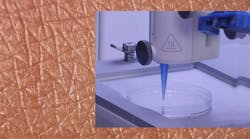Researchers at Rensselaer Polytechnic Institute have developed a way to 3D print living skin, complete with blood vessels. The advancement is a significant step toward creating grafts that are like the skin our bodies produce naturally.
“Right now, whatever artificial skin is available as a clinical product is more like a fancy Band-Aid,” says Pankaj Karande, an associate professor of chemical and biological engineering at Rensselaer. “It provides some accelerated wound healing, but eventually just falls off; it never really combines with other skin cells.”
A significant barrier to that integration has been the absence of functioning vascular blood vessels in the skin grafts.
Karande has been working on this challenge for several years, and has shown that researchers can turn two types of living human cells into “bio-inks” and print them into a skin-like structure. Since then, he and his team have been working with researchers from Yale School of Medicine to add blood vessels.
He and his team recently discovered that if they add key elements, including human endothelial cells (which line the inside of blood vessels) and human pericyte cells (which wrap around the endothelial cells), along with animal collagen and other structural cells typically found in a skin graft, the cells start communicating with each other and form a blood vessel network within a few weeks.
Once the Yale team grafted it onto a special type of mouse, the vessels from the skin printed by the Rensselaer team began to communicate and connect with the mouse’s own vessels.
“That’s extremely important, because we know there is actually a transfer of blood and nutrients to the graft which keeps the graft alive,” Karande says.
To make this “skin” useful, the team needs to be able to edit the donor cells using something like CRISPR technology, so that the vessels can be accepted by the patient’s body.
Karande says more work will need to be done to address the challenges associated with burn patients, which include the loss of nerve and vascular endings. But the grafts his team has created bring researchers closer to helping people with more discrete skin problems, like diabetic or pressure ulcers.
“For those patients, these would be perfect, because ulcers usually appear at distinct locations on the body and can be addressed with smaller pieces of skin,” Karande says. “Wound healing typically takes longer in diabetic patients, but this could accelerate that process.”

